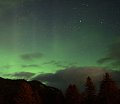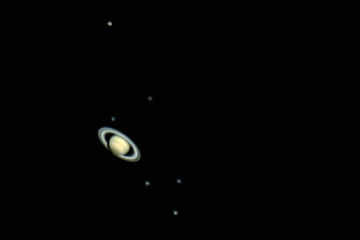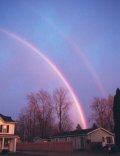Would you like a call when auroras appear over your home town? Sign up for Spaceweather PHONE.
WEAK IMPACT: A coronal mass ejection (CME) swept past Earth on April 9th at approximately 0200 UT, but its impact was weak. The passing cloud triggered only a short-lived G1-class geomagnetic storm. Northern Lights appeared briefly over some parts of Canada and Alaska.
 More widespread auroras are possible tonight for two reasons: (1) Earth is heading for a solar wind stream flowing from a coronal hole on the sun, and (2) another CME (movie) is heading our way. The cloud was hurled toward Earth by a C7-class explosion from sunspot 588 on April 8th (1030 UT), and it should arrive on April 10th.
More widespread auroras are possible tonight for two reasons: (1) Earth is heading for a solar wind stream flowing from a coronal hole on the sun, and (2) another CME (movie) is heading our way. The cloud was hurled toward Earth by a C7-class explosion from sunspot 588 on April 8th (1030 UT), and it should arrive on April 10th.
Right: Auroras over Kincolith, British Columbia, on April 8th. Credit: Yuichi Takasaka. [gallery]
SPACE STATION FLYBY: On April 1st, Torsten Edelmann of Landsberg, Germany, photographed a rare and beautiful close encounter ... between Saturn and the ISS:

"This is no April Fool's joke," says Edelmann, who recorded the event using a Celestron C9.25 telescope and a Phillips Toucam digital camera. "The two frames showing the ISS are just 1/15s apart! I processed the image of Saturn separately to enhance the planet's faint moons."
 SUNSET RAINBOWS: It was a cold and rainy day in Memphis, Michigan, but just before sunset, "the blazing sun came through, lit up the drizzle, and produced these brilliant rainbows," says photographer William Biscorner. The double 'bows were not only bright, but also remarkably high.
SUNSET RAINBOWS: It was a cold and rainy day in Memphis, Michigan, but just before sunset, "the blazing sun came through, lit up the drizzle, and produced these brilliant rainbows," says photographer William Biscorner. The double 'bows were not only bright, but also remarkably high.
Atmospheric optics expert Les Cowley explains: "Close to sunset, rainbows are at their highest in the sky because their center is directly opposite the sun. The lower the sun, the higher the bow. The inner primary bow is produced by light reflected once inside raindrops. Light escaping after two internal reflections forms the outer secondary bow with reversed colors."
"Sunset bows are often reddened," Cowley adds. "When you see them, check the sky towards the sun; most light passes through raindrops without a reflection and can flood the sunward sky with beautiful oranges and reds."

